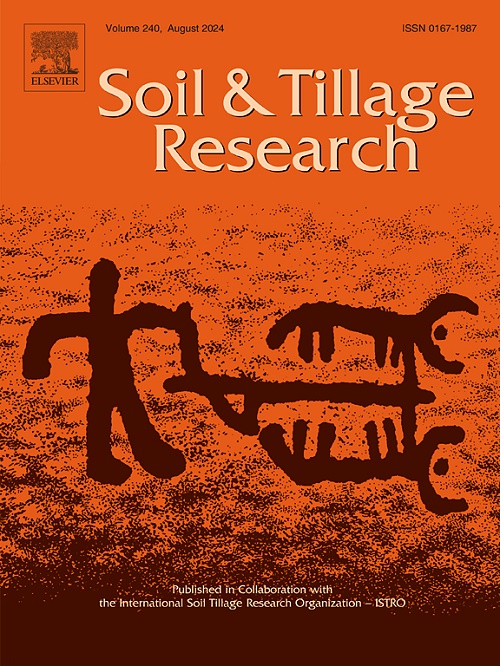Optimizing straw return to enhance grain production and approach carbon neutrality in the intensive cropping systems
IF 6.1
1区 农林科学
Q1 SOIL SCIENCE
引用次数: 0
Abstract
Straw return into agricultural soil is beneficial to agricultural production and has been widely recommended as a practice to enhance both productivity and soil fertility. However, long-term excessive straw return may be detrimental in intensive and high-yielding cropping systems. Here, we conducted a 3-year field experiment in a wheat-maize (Triticum aestivum and Zea mays) double cropping system to investigate the impacts of various straw return rates on crop productivity and carbon footprint. The soil type of the experimental site is Hapludalf. Our results revealed that during the study period from 2014 to 2017 returning 50 % of the straw from both crops (about 3.8 t C ha−1 input) led to maximum increase in grain yield by 15 % and the maximum efficiency of soil to sequestrate 24 % of carbon contained in returned straw. Returning only 25 % of straw (2.0 t C ha−1 input) maintained the relative balance of soil carbon. 75 % straw return (5.4 t C·ha−1 straw carbon) resulted in the maximum soil carbon sequestration of 0.8 t C ha−1 yr−1 and minimum carbon footprint of 2.4 t CO2-eq ha−1, but more straw return did not produce significant positive benefits. Straw return promoted farmland CO2 emission, which was equivalent to 43 % of the straw carbon input. Each 25 % increase of straw return amount increased the total direct N2O emissions by 0.5 kg N2O ha−1. Our results clearly indicate that the currently and widely practiced straw management i.e. returning all wheat and maize straw, leads to excessive carbon return, causing imbalance of soil carbon and nutrient and reduced crop yield, is therefore not the best options. Returning 50–75 % of crop straw and using the rest as stock feed, will boost crop productivity while maintaining lower carbon footprint. Our approach provides a practical and reliable method to develop a "win-win" strategy for straw management in the double-cropping systems. The optimal straw management will change with time due to changed climate, soil and management conditions,while the approach can be applied to investigate optimal straw management in all systems across environments. Although our study is constrained to short-term observations, the findings provide valuable guidance for the development of mutually beneficial crop straw management strategies and establish a solid foundation for future long-term research in this area.
优化秸秆还田,提高集约种植系统的粮食产量,实现碳中和
秸秆还田有利于农业生产,已被广泛推荐为提高生产力和土壤肥力的做法。然而,在集约高产种植制度中,长期过量秸秆还田可能是有害的。本研究以小麦-玉米(Triticum aestivum和Zea mays)双季制为试验材料,研究不同秸秆还田率对作物生产力和碳足迹的影响。试验点土壤类型为单峰型。结果表明,在2014年至2017年的研究期间,两种作物秸秆还田50% %(约3.8 t C ha - 1投入)可使粮食产量最大增加15 %,土壤对还田秸秆碳的最大固存效率为24 %。仅还田25% %秸秆(2.0 ~ C ha−1)即可维持土壤碳的相对平衡。75% %秸秆还田(5.4 t C·ha−1秸秆碳)最大固碳量为0.8 t C·ha−1 yr−1,最小碳足迹为2.4 t CO2-eq ha−1,但更多秸秆还田并未产生显著的正效益。秸秆还田促进农田CO2排放,相当于秸秆碳投入的43% %。秸秆还田量每增加25 %,N2O直接总排放量增加0.5 kg N2O ha - 1。我们的研究结果清楚地表明,目前广泛实行的秸秆管理,即全部归还小麦和玉米秸秆,导致过度的碳返还,导致土壤碳和养分失衡,降低作物产量,因此不是最佳选择。退回50 - 75% %的农作物秸秆,并将其余部分用作饲料,将提高作物生产力,同时保持较低的碳足迹。我们的方法为制定双季制秸秆管理的“双赢”策略提供了一种实用可靠的方法。由于气候、土壤和管理条件的变化,秸秆最优管理会随着时间的变化而变化,该方法可应用于研究跨环境下所有系统的秸秆最优管理。虽然我们的研究仅限于短期观察,但研究结果为制定互利作物秸秆管理策略提供了有价值的指导,并为该领域未来的长期研究奠定了坚实的基础。
本文章由计算机程序翻译,如有差异,请以英文原文为准。
求助全文
约1分钟内获得全文
求助全文
来源期刊

Soil & Tillage Research
农林科学-土壤科学
CiteScore
13.00
自引率
6.20%
发文量
266
审稿时长
5 months
期刊介绍:
Soil & Tillage Research examines the physical, chemical and biological changes in the soil caused by tillage and field traffic. Manuscripts will be considered on aspects of soil science, physics, technology, mechanization and applied engineering for a sustainable balance among productivity, environmental quality and profitability. The following are examples of suitable topics within the scope of the journal of Soil and Tillage Research:
The agricultural and biosystems engineering associated with tillage (including no-tillage, reduced-tillage and direct drilling), irrigation and drainage, crops and crop rotations, fertilization, rehabilitation of mine spoils and processes used to modify soils. Soil change effects on establishment and yield of crops, growth of plants and roots, structure and erosion of soil, cycling of carbon and nutrients, greenhouse gas emissions, leaching, runoff and other processes that affect environmental quality. Characterization or modeling of tillage and field traffic responses, soil, climate, or topographic effects, soil deformation processes, tillage tools, traction devices, energy requirements, economics, surface and subsurface water quality effects, tillage effects on weed, pest and disease control, and their interactions.
 求助内容:
求助内容: 应助结果提醒方式:
应助结果提醒方式:


